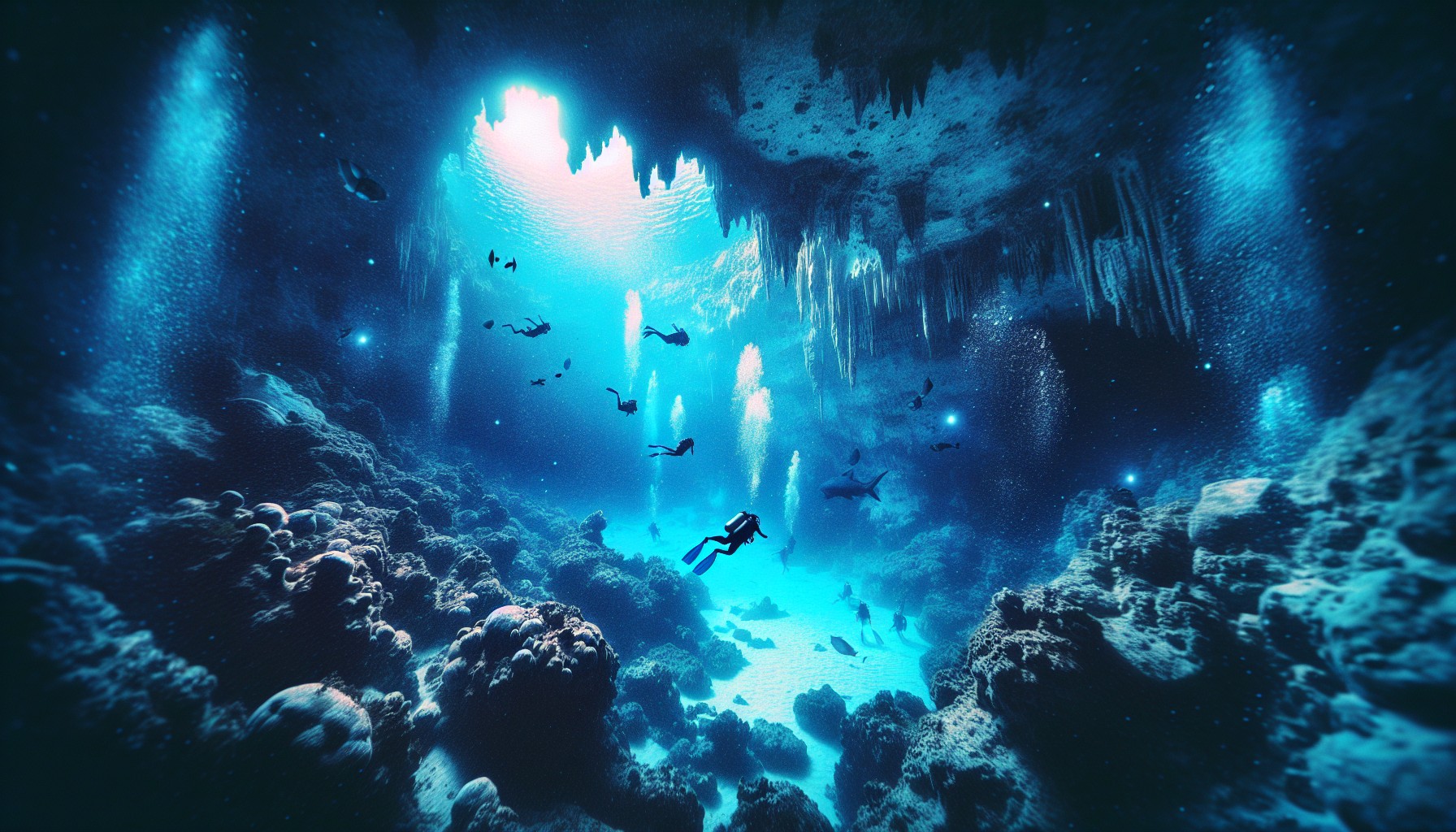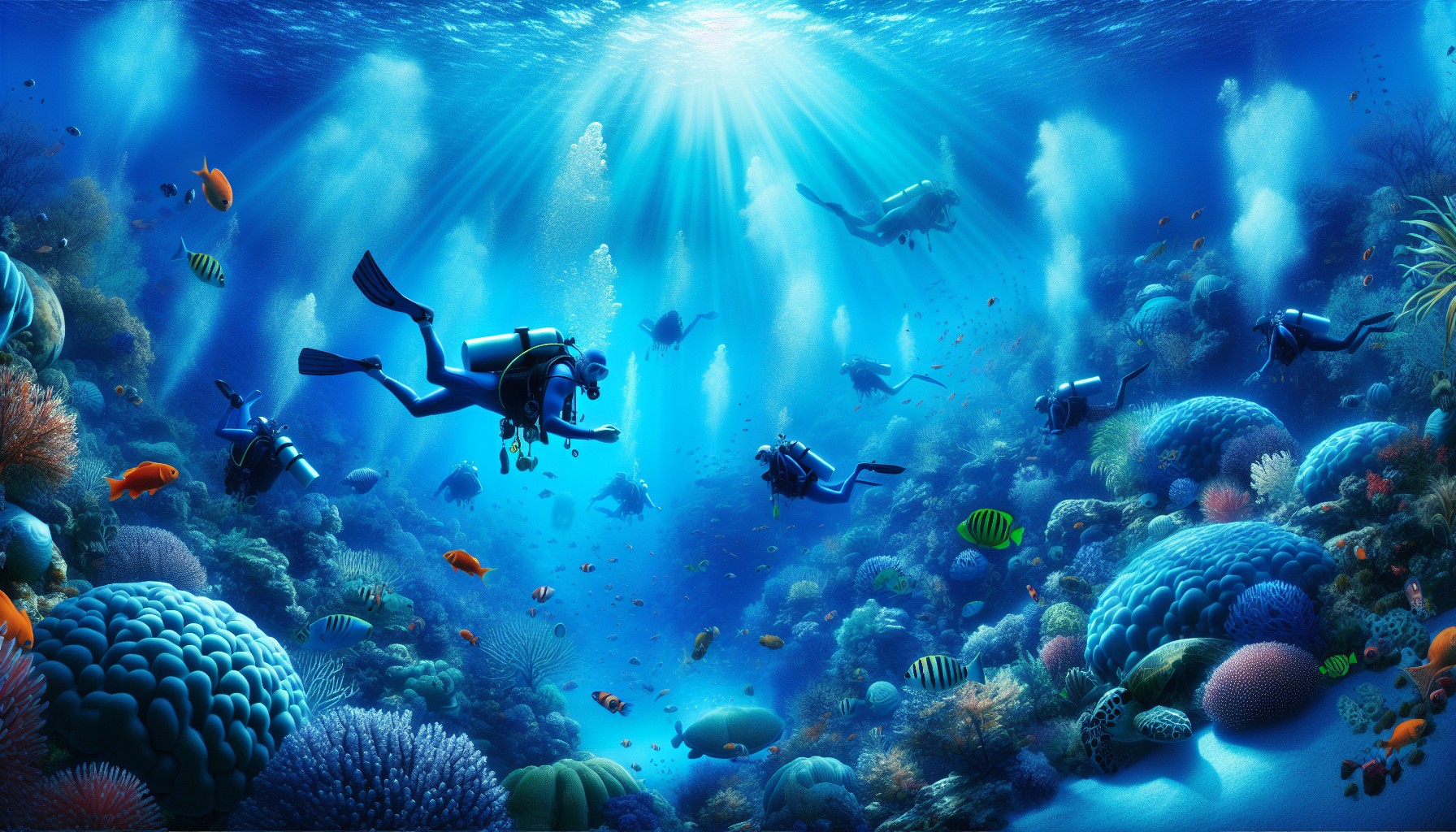Exploring Cenote Diving in Cancun
Dive headfirst into the magic of cancun cave diving. Hidden in the Yucatan Peninsula are wonders called cenotes – nature’s sinkholes that invite scuba fans for an unforgettable dip.
Cenotes: Mexico’s Natural Wonders
In Mexico’s Yucatan, thousands of cenotes wait, each with its own bit of magic. The Sac Aktun system is one for the record books with 138 miles (222km) stretching underground and linking with 226 sinkholes. Go deep and discover cenotes reaching 390ft (119m) down.
These are no usual water spots. They’re gateways to stunning sights. Expect crystal waters, cool rock forms like stalactites and stalagmites, and even traces of ancient Maya life. Natural light sneaking in through crevices paints incredible scenes perfect for photography.
Unique Underwater Experiences
Get lost in Tulum’s cenotes, a quick 50-minute drive from Playa del Carmen. Jump into Dos Ojos, Ponderosa, Tajma Ha, Carwash, Angelita, and Gran Cenote. The vistas and marine surprises here will blow you away. At Dos Ojos Park, over 10 cenotes await, each weaving their own special story (World Adventure Divers).
As you glide into those glassy waters, tranquility takes over. Graceful stalactites greet you. See freshwater meet saltwater in shimmering haloclines. Light dances around, creating a peaceful wonderland. With year-round water temperatures holding at a comfy 25 to 27 degrees Celsius (75 to 80 degrees Fahrenheit) and clear visibility, it’s a diver’s dream world (Maya Blue Dive Center).
Let the cenotes of Cancun sprinkle a little magic on your adventure. These hidden treasures offer a sneak peek into nature’s marvel, each dive a chance to carry home a treasure trove of memories under Mexico’s mystical waters.
Safety Measures and Requirements
Cave diving in Cancun’s cenotes isn’t just your average swim with the fish. It takes precision planning and top-notch safety practices to plunge into these watery wonders. Understanding cave diving certification and being up to speed with the right gear and puff management (that’s the air in your tank) is key to keeping things safe down there.
Cave Diving Certification
Think of cave diving certification like a hardcore survival course, but underwater. If you’re keen on exploring the hidden waterscape of Cancun’s cenotes, you’ve got to earn this badge of honour. Unlike regular diving, it zeroes in on navigating the tight, twisty world of caves. It’s got its own set of challenges that require a specialized skill set.
Now, before you go off jumping into any dive, there’s quite a bit of schooling involved. You’ll learn to keep your cool, float just right, swim without causing a ruckus, and handle sticky situations like a pro. Usually, it all starts with the basics, such as Open Water certification – a must-have for wannabe cave divers (Koox Diving).
Equipment and Gas Management
When you’re diving in caves, treating your gear like your best mate can make all the difference. Divers stick by the rule of thirds – don’t use more than a third of your air going in, another third heading out, and keep the rest for those “oops” moments. In these tunnels of wonder, running out of air ain’t an option (Koox Diving).
You’ll need more than just your standard flippers and mask. We’re talking super-bright torches, back-up air supplies, and spools of line for when you need to find your way back. Every piece of gear should be in tip-top shape and familiar as the back of your hand before you take a sink. Prepping your gear and knowing how to manage your air not only gives you peace of mind but makes sure your dive is a hit without any hitches. So, gear up right and get set to explore the spellbinding sinkholes of Cancun with safety as your sidekick.
Dive Preparation and Guidelines
When stepping into the mysterious vibes of Cancun cave diving, it’s all about being ready and sticking to some basic rules to have a cool and safe time. Two of the big ones are keeping your guideline sorted and making sure your lighting’s on point.
Keeping Track of Your Guideline
Knowing how to handle a guideline is crucial in cave diving so you don’t end up wandering aimlessly in these maze-like underwater passages. Getting the knack for putting down a line and using it to find your way is a must for any cave diver. Sticking to the guideline isn’t just helpful; it’s the ticket back to daylight. Make sure you’re up to speed on the guideline techniques – they’re your best mate when navigating the wet, dark corners of cave systems. If you’re curious about becoming a cave diving pro, swing by our piece on Cancun diving certification.
Light Source Must-Haves
In the pitch black of those underwater caves, light is your best friend. It’s smart to pack three lights – your main torch and two extras – to help you see where you’re going. Go for lights with narrow beams to focus on the bits you really want to see, and double-check they’ve got fresh batteries for the whole outing. Dive into more tips with our guide on Cancun scuba diving packages.
Your torches aren’t just for seeing stuff, they’re part of your safety net. Each one is ready to kick in if your main light gives up on you. Stick to the rules about lights and keeping them in check, and your trip will be smoother and safer.
When you’re gearing up for a dive in these caves, always be thinking safety first. Stick to what you know, make sure you’ve got all your gear, and don’t push it. With the right prep and a bit of respect for the dive rules, you’ll enjoy exploring the magical underwater sights of Cancun, knowing you’ve got it all covered.
Best Cenotes for Diving
If you’re itching for a jaw-dropping experience in Cancun’s underwater world, then a trip to the cenotes in Tulum, Valladolid, and Bacalar is definitely on the cards. Each spot is brimming with charm and adventure just begging to be explored.
Tulum’s Cenote Hotspots
Ah, Tulum – just a hop, skip, and a 50-minute jump south of Playa del Carmen. This place is like a dive-crazy wonderland with a string of enchanting cenotes that pull in diving enthusiasts from all corners of the globe. Fancy names like Dos Ojos, Ponderosa, Tajma Ha, Carwash, Angelita, and Gran Cenote dance off the tongue, each offering a splash of their own unique underwater thrill. Just venture into Dos Ojos Park and you’re met with over 10 cenotes, each packing its own punch with fascinating features and a fair dose of challenges (World Adventure Divers).
Dive into Tulum’s clear-as-day waters and you’ll stumble upon glorious rock formations and vibrant life lurking beneath the surface. Whether you’re a cave-diving pro or a fresh face eager to dip a toe in, Tulum’s cenotes have a little something for everyone. Don’t miss out on checking the different cenote diving packages on offer to make sure your underwater escapade is nothing short of legendary (cancun scuba diving packages).
Valladolid and Bacalar Cenote Experiences
The cenotes of Valladolid may not roll out the scuba diving welcome mat due to their depth and quirks, but man, what a sight they are. These grand, gaping natural wonders are perfect for those moments when you just want to float about, taking in nature’s marvels in a unique swimming and sightseeing experience.
Bacalar, on the other hand, is more known for its splash and dash. Here, cenotes mostly call out to swimmers. Imagine dipping into stunning lagunas featuring stromatolites sanctuaries – a snorkeler’s paradise! These watery hideaways let you dive into a world where you get cozy with a variety of marine life, all while enjoying some of the clearest water around.
Choose to swim beneath Tulum’s crystalline surfaces, or simply chill with the vistas in Valladolid and Bacalar. Each spot offers up memories and stories to take home with you. Just a quick reminder: book your Cancun diving tours ahead of time to snag your spot and guarantee an epic time on your Cancun cave diving escapade.
Seasons and Conditions
Planning a cave diving trip in Cancun involves knowing when to go for the best experience (and to keep things safe) during the year. If you’re up for some cancun cave diving, it’s smart to pay attention to how the dry and wet seasons play a part in your underwater journey.
Dry Season Diving
Come November, the dry season rolls in, and with it, a dive-friendly atmosphere. The Yucatan Peninsula offers coolish 23°C waters perfect for taking the plunge. It’s kind of the “quiet” season with fewer folks around, meaning you might score better digs at a lower cost. Rolling through to April, this season is when cenote diving is at its best, drawing in adventurers wanting to check out Mexico’s natural happenings (Maya Blue Dive Center).
Wet Season Considerations
Then there’s the wet season kicking off in June, throwing a twist into the mix. Expect more rain and gusty days which can shake up the surface vibe and reduce how far you can see in the cenotes. And there’s also this blue-greenish algae that sometimes makes things a bit murky up top. But drop below and the waters clear up quick, offering a striking scene for those brave enough to take the plunge this time of year (Maya Blue Dive Center).
Knowing what each season brings helps scuba divers line up their cave diving trips in the best way possible, keeping seasonal shifts in mind. Whether it’s the calm, clearer cabinets of the dry season you want or the stand-out oddities during the wet, there are always golden moments to grab when diving into the stunning cenotes of Cancun.
Expertise and Medical Considerations
To keep the thrill of cave diving in Cancun both unforgettable and worry-free, divers need the right skills, a thumbs-up from a doctor, and a green approach to protect nature. Sound like a lot? Not to worry. Let’s break it down into bite-sized pieces so you’re geared up for this adventure.
Diving Skill Requirements
When jumping into Cancun’s cave diving scene, it’s not just a dip in the pool. Divers need serious chops. The folks over at Cancun Scuba Center reckon that wannabe cave divers should handle buoyancy like a pro and master the nitty-gritty of diving skills. You gotta dive like you’ve done it a million times—methodical and disciplined.
In those dark, twisty underwater caves of Cancun, it’s crucial to cling to strict safety rules and show you know the ropes when things get tricky. You need to be savvy with maps and prepared for underwater curveballs. It’s about staying cool as a cucumber while booking it through the maze down there.
Medical Authorization and Eco-Friendly Practices
Before going for any Cancun diving shenanigans, if you’ve got buddy issues like heart matters, asthma, high blood pressure, or epilepsy, it’s time to get a doctor’s note. This isn’t just paperwork; it’s making sure your health can keep pace with the challenges of cave diving and avoiding any nasty surprises underwater (Cancun Scuba Center).
Being kind to Mother Nature is also a biggie. In Cancun’s cenotes, divers need to tread lightly and follow some simple eco-friendly rules. No poking at the fish, hands off the corals and formations, and, of course, take your trash with you or find a bin. It’s all about diving with a conscience and keeping those caves beautiful for everyone.
By ticking off the skills checklist, getting the health okay, and diving with the planet in mind, divers can soak in the mysterious beauty of Cancun’s underwater world. All this while playing it safe and being a good sport to Mother Nature.



